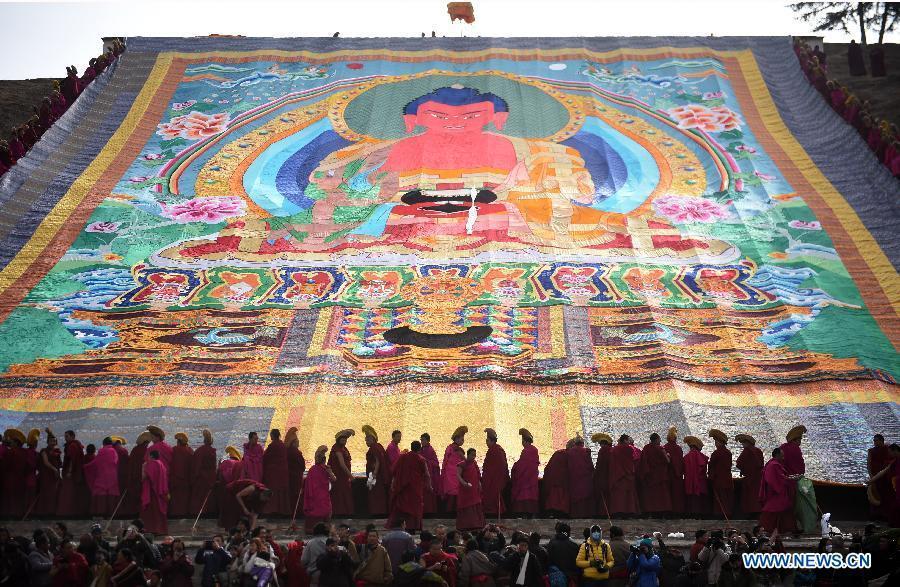Source:Xinhua 2016-04-08

Buddhists attend the annual ritual displaying of a gigantic Buddha tangka (Tibetan religious painting) alongside a hillside for disciples' worship at the Labrang Monastery in Xiahe County, northwest China's Gansu Province, March 3, 2015. The Buddha tangka display, or "the basking of Buddha", is a Tibetan Buddhism traditional praying for a good year. [Photo/Xinhua]
When Sanggyaipo was taught to write the Tibetan alphabet in school in northwest China's Qinghai Province, he mischievously drew a mini Buddha with every stroke.
So began a passion for ethnic art that has seen Sanggyaipo, now 51, become a star of thangka, Tibetan Buddhist scroll paintings that have become fashionable -- and highly profitable -- in recent years.
A giant thangka that Sanggyaipo has recently completed after five exhausting years of research and painting is due to go on display in Beijing later this year. Here is the story of how he became a leading Chinese artist, pulling himself up from poverty and helping repair threatened Tibetan antiques along the way.
After school, young Sanggyaipo spent most of his time watching thangka masters in his village, the Tibetan autonomous prefecture of Huangnan, a cradle of thangka painting.
Sanggyaipo was eager to have a go himself. Life was hard and his family could not afford to buy him decent paper, but he enjoyed painting all the same, on used woven bags which he had cut into pieces.
After he finished middle school at 16, he began an apprenticeship with Gyaimoco, one of the great thangka painters. Sanggyaipo spent more than 10 years in his master's house, learning painting techniques and helping with the household chores in his spare time.
PAINTING BUDDHA'S SCROLLS
Sanggyaipo was starting to win acclaim for his art in the early 1990s, when a pilgrimage to the major Taer Monastery led to a lucky break that was to change his life.
The senior Buddhist who blessed Sanggyaipo asked his profession. "He was apparently impressed when I told him I was a thangka painter. He asked me to write down my permanent address," Sanggyaipo remembered.
A few days later, the senior Buddhist visited his family with a job offer: to help with a state-financed project to repair murals at Taer Monastery.
Sanggyaipo and eight other thangka painters spent three years restoring the original look of 36 murals at the monastery.
He earned about 30,000 yuan for the job, a considerable amount for his impoverished family. "Taer Monastery was the birthplace of Tsongkhapa, the founder of the Yellow Hat Sect of Tibetan Buddhism. As I painted Buddha's scrolls, I earned my first fortune right there under His watchful eyes," said Sanggyaipo.
He spent another two decades repairing more murals and thangka at monasteries in Qinghai and Gansu provinces and even at the Potala Palace in Lhasa, experiences he views as a "special honor."
Throughout the years, he kept learning and sharpening his skills. He was named head of a national thangka academy and one of his works has been housed at the United Nations headquarters in New York.
A LIFE'S WORK
Sanggyaipo's latest work, the 56-meter-long thangka on its way to Beijing, has been a long time in gestation.
The 10th Panchen Lama, the head of Tibetan Buddhism in China, visited Huangnan in 1982 and met Gyaimoco.
"I saw my teacher was in tears when the Panchen Lama told him to preserve Tibetan culture and carry forward thangka art," recalled Sanggyaipo, who was 17 at the time.
These words were inspiring. In 2011, Sanggyaipo decided to paint a thangka of all the Panchen Lamas from the first to the current 11th.
Over the course of five years, he traveled to Tibet many times to buy the best pigments, and to India for cotton and silk, the ideal canvas for thangka scrolls.
Sanggyaipo also followed the Panchen Lamas' footsteps to Lhasa, Beijing and Yunnan Province, collecting more than 15,000 photos of the high monks.
He chatted with elderly Buddhists who were able to give him vivid details from the early life of the latest Panchen Lamas. He and 60 other thangka painters incorporated some of these details into the painting.
Sanggyaipo hopes the work will "exhibit the charm of Tibetan art and show my respect for the Panchen Lamas."
SPIRITUAL CALLING
Painting has earned Sanggyaipo a solid living, as prices for thangka have soared now Tibetan art hangs in middle-class homes and regularly fills gift boxes. Most Thangka paintings now sell for at least 10,000 yuan (1,575 U.S. dollars).
Popularity and profitability, however, are not always good for art. Good thangka painters need to have exacting attention to detail, and it helps to have the spirituality of Buddhism, according to Sanggyaipo.
The artist himself gets up at 6 a.m. every day to read sutra. "It's a daily habit to help me meditate and be self-disciplined," he explained.
"Many thangka works are painted too hastily these days, as if they are all done on the same production line," he complained. "They lack the charm you feel with earlier works that were done in monasteries and by devout Buddhists who were expert in painting as well as Buddhist teaching."
Now that thangka painting has become lucrative, Sanggyaipo has found a growing number of young people interested in taking up the occupation.
He has taught more than 50 students to paint thangka, but many lack the concentration and determination for it. As Sanggyaipo said, "If a young man cannot sit still and resist the temptations of computers and smartphones, he can never learn to paint thangka well."
Copyright © Xizang Daily & China Xizang News All rights reserved
Reproduction in whole or in part without permissions prohibited
Index Code: 藏 ICP 备 05000021 号
Producer: Xizang Daily International Communication Center